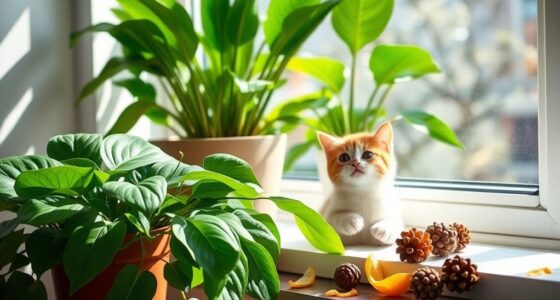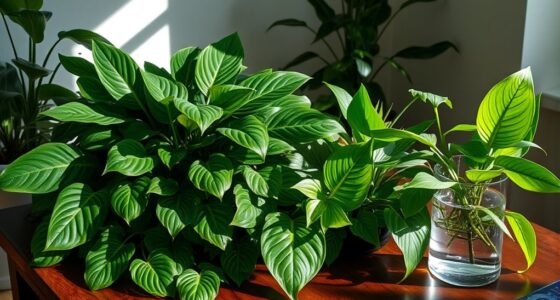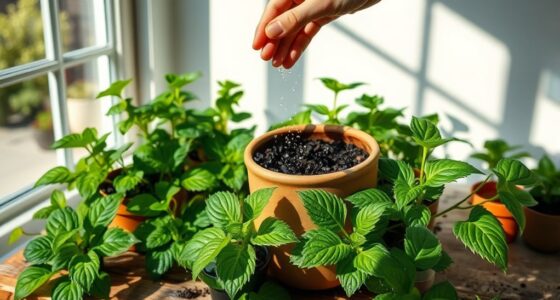Yes, ferns are excellent indoor plants! They purify the air by removing harmful pollutants and boost humidity, improving overall air quality. Ferns create a calming atmosphere, helping to reduce stress and anxiety. Plus, they thrive in low-light conditions, making them versatile for various spaces. With proper care and maintenance, ferns can flourish indoors. Discover more about the different fern varieties, their ideal growing conditions, and how to keep them healthy.
Key Takeaways
- Ferns effectively purify the air, absorbing harmful pollutants and improving indoor air quality by up to 87%.
- They thrive in high humidity and help alleviate dry skin and respiratory issues.
- Ferns create a calming atmosphere, reducing stress and promoting overall well-being.
- Many fern varieties, such as the Boston and Bird’s Nest Fern, are versatile and adaptable to indoor conditions.
- Their natural sound barrier properties enhance tranquility, making them excellent additions to any indoor space.
Benefits of Ferns as Indoor Plants
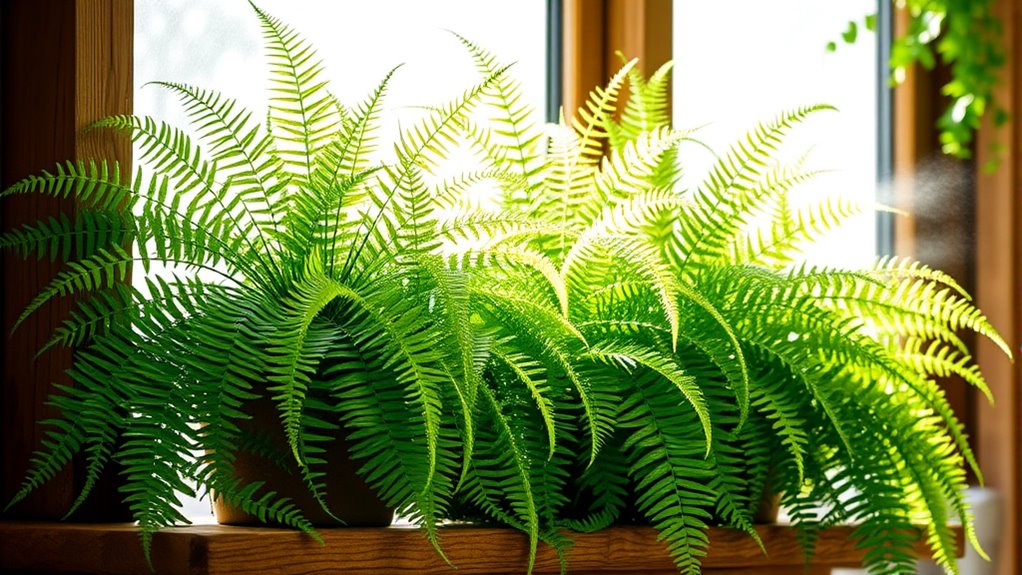
When you bring ferns into your home, you’ll enjoy a range of benefits that enhance both your indoor environment and well-being.
Incorporating ferns into your home enhances your environment and well-being with their air-purifying and calming benefits.
These lush plants purify the air by absorbing harmful pollutants, making your space healthier. They also help regulate humidity by releasing moisture, which can combat dry air and its associated health issues. Additionally, Boston ferns can reduce levels of carbon dioxide and other pollutants by up to 87%, contributing to a cleaner atmosphere.
You’ll find that ferns create a calming atmosphere, reducing stress and anxiety. Plus, their foliage acts as a natural sound barrier, cutting down on indoor noise.
Aesthetically, ferns add a vibrant, tropical feel to any room, elevating your decor.
With all these advantages, incorporating ferns into your living space can significantly improve your overall quality of life.
Types of Indoor Ferns

Incorporating ferns into your indoor environment not only enhances your space but also offers a variety of options to suit different aesthetics and conditions.
For instance, the Boston Fern with its long, arching fronds creates a lush vibe in hanging baskets. If you prefer delicate foliage, the Maidenhair Fern‘s fan-shaped fronds are perfect for terrariums. The unique Staghorn Fern, known for its antler-like fronds, can be mounted for a striking display. For low-light areas, consider the Blue Star Fern or Rabbit’s Foot Fern, both of which are tolerant of low light. Additionally, creating living spaces that accommodate plants can significantly enhance the quality of life for seniors. Ferns, like the Bird’s Nest Fern, not only thrive in humidity but also contribute to improved air quality in your home. Each type of fern brings its own charm, allowing you to curate a beautiful indoor landscape tailored to your preferences. Moreover, emotional impact of music can enhance the overall ambiance of your indoor environment, making it more inviting.
Ideal Growing Conditions for Ferns
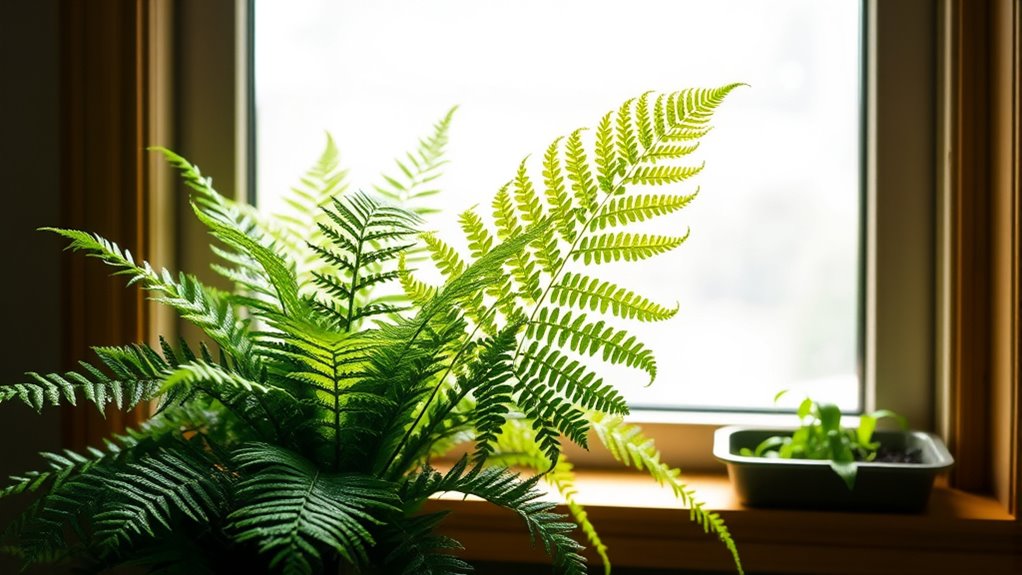
To ensure your ferns flourish indoors, it’s crucial to provide the right growing conditions. They thrive in bright, indirect light, so place them near north or east-facing windows. Avoid direct sunlight, which can scorch their delicate leaves. Aim for daytime temperatures between 65-75°F (18.3-24°C) and allow a slight drop at night. Ferns love high humidity, ideally above 50%, so consider using a humidifier or placing them in your bathroom. Using well-draining, organic-rich potting mix is essential for their growth as it retains moisture without becoming soggy. Creating your perfect backyard greenhouse can also help in growing a variety of plants, including ferns, in a controlled environment. Regular grooming can help maintain plant health, just as it does for pets, ensuring your ferns look their best. Ensure good air circulation to prevent disease, as stagnant air can lead to fungal issues. Water when the top layer of soil feels dry, and ensure good air circulation to prevent disease.
Provide your ferns with bright, indirect light near north or east-facing windows for optimal growth.
With these conditions met, your ferns will thrive and enhance your indoor space beautifully.
Care and Maintenance Tips

Caring for your ferns involves a combination of proper watering, light management, and periodic maintenance. Water your ferns weekly, ensuring the top inch of soil is dry before adding room-temperature water. Keep the soil consistently moist, but avoid sogginess to prevent root rot. Ferns thrive in humidity levels between 30-50%, so consider using a humidifier or misting the leaves regularly. It’s important to remember that ferns require consistently moist soil to thrive. Additionally, ensuring proper airflow around the unit can help maintain the necessary humidity levels. Regularly monitoring your ferns for signs of stress can help you adjust their care to meet their specific needs.
To further enhance indoor air quality, consider placing your ferns alongside an air purifier to filter out common allergens and improve overall well-being.
Place your ferns in bright, indirect light, ideally near north- or east-facing windows. Shield them from direct sunlight to prevent leaf burn. Use a well-draining soil mix rich in organic matter, and fertilize with a low-nitrogen liquid fertilizer during the growing season. Prune dead fronds anytime to encourage fresh growth and keep leaves dust-free for optimal health.
Health Benefits of Keeping Ferns Indoors
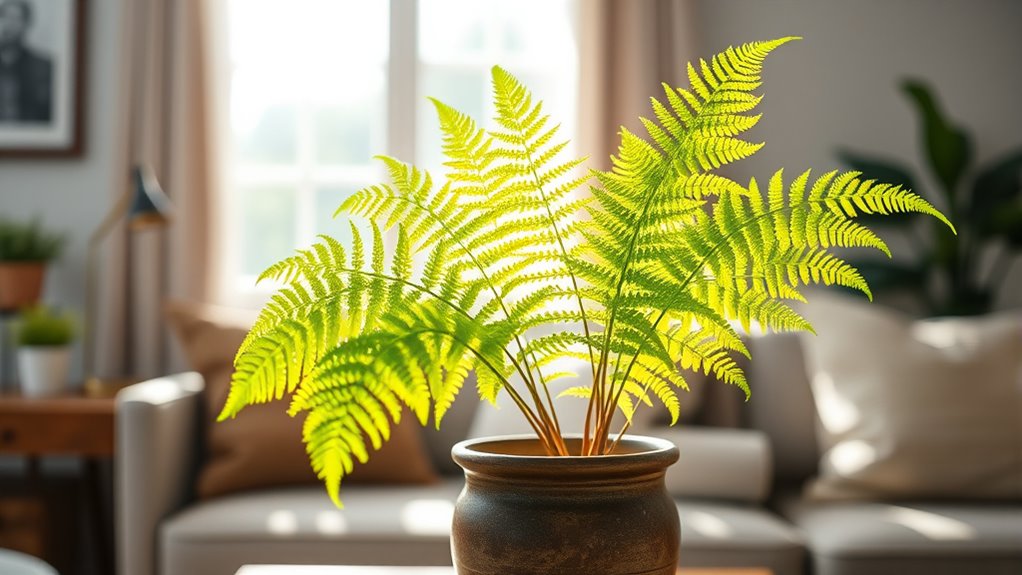
Keeping ferns indoors not only enhances your living space but also offers a range of health benefits. These plants purify the air by removing pollutants, improving your indoor air quality. You’ll find that having ferns can reduce symptoms of anxiety and depression, promoting a sense of well-being. This is especially true for the Boston fern, which is effective at removing harmful air pollutants. Caring for them can lower your stress levels, creating a calming environment. Ferns also help maintain healthy humidity, alleviating dry skin and respiratory issues, and their ability to produce oxygen contributes significantly to a healthier indoor atmosphere. Additionally, they complement the use of air purifiers by enhancing overall air quality. Furthermore, studies show that indoor plants like ferns can reduce air pollution levels indoors, leading to improved health outcomes. Plus, they produce oxygen, which can improve your sleep quality. By incorporating ferns into your home, you’ll enjoy a connection to nature, enhance your mood, and support emotional balance, making your indoor environment both soothing and inviting.
Challenges of Growing Ferns Indoors

While ferns offer numerous health benefits, growing them indoors can come with its own set of challenges.
These plants typically need bright, indirect light, as direct sunlight can cause leaf burn, particularly in holly ferns. Maintaining humidity levels between 30-50% is crucial, and you’ll need to keep temperatures consistent, ideally between 65-75°F during the day. Most ferns prefer cool temperatures and high humidity, which can be difficult to achieve in modern indoor environments. Implementing the “one in, one out” rule can also help manage space when introducing new plants into your home. To maintain optimal conditions, consider using a portable humidifier to enhance humidity levels. Additionally, using self-watering planters can help maintain consistent moisture without the risk of overwatering.
Watering requires a careful balance—too much can lead to root rot, while too little can cause dehydration. Additionally, pests like spider mites can become a problem if humidity is low.
Avoid common mistakes, such as inadequate humidity and incorrect watering, to keep your ferns healthy. With the right care, you can successfully navigate these challenges and enjoy your indoor ferns.
Best Locations for Placing Indoor Ferns
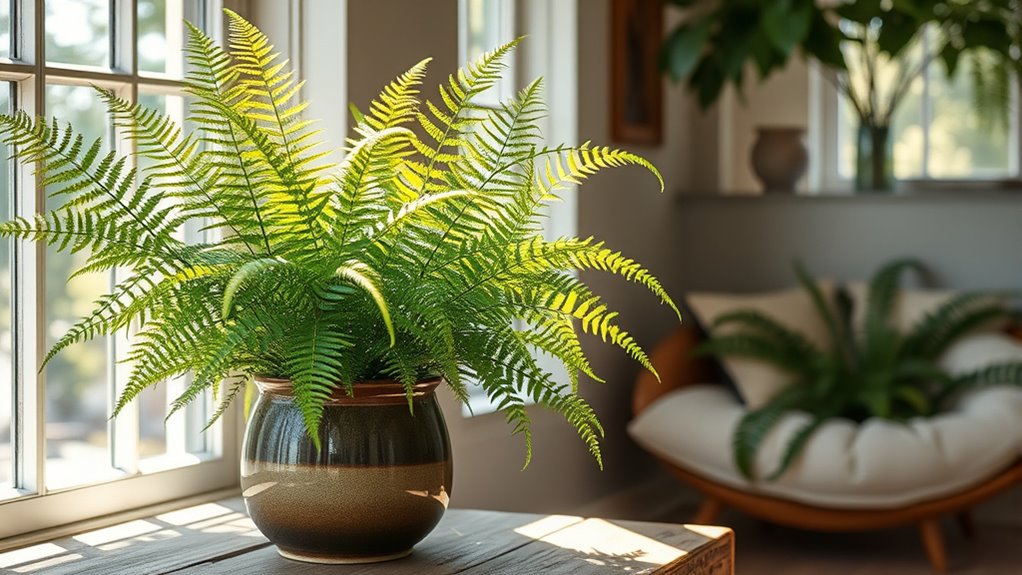
Finding the best locations for your indoor ferns is essential for their health and vitality. Most ferns thrive in moderate, indirect light, making north-facing windows ideal. Avoid placing them directly in south or west-facing windows, as the light can be too intense. If natural light is lacking, consider using artificial lights. Ferns also love humidity, so bathrooms are perfect due to their naturally higher moisture levels. To maintain humidity, use pebble trays, but steer clear of heating vents. Various types of ferns have unique care requirements, so be sure to consider the specific needs of the ferns you choose. Additionally, many ferns benefit from high humidity levels, which further supports their growth and vitality. Research shows that maintaining appropriate temperature matters too; keep daytime temperatures below 72°F and nighttime temperatures under 60°F. Lastly, place ferns where you can easily access them for watering and care, avoiding high-traffic areas to protect those delicate fronds. Ensuring a consistent environment for your ferns can significantly enhance their overall health and growth.
How to Propagate Indoor Ferns
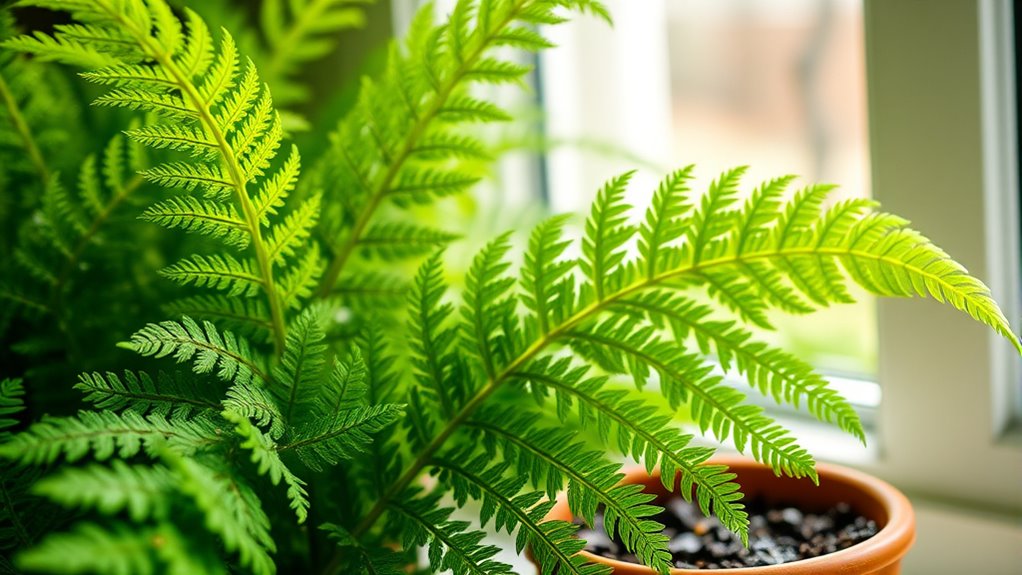
If you want to expand your collection of indoor ferns, propagation offers a fulfilling way to do so. You can choose from several methods.
For spore propagation, collect mature fronds and gather the spores, then spread them on a prepared medium and maintain humidity until germination. This method allows for greater genetic diversity among the resulting plants. Engaging in this process can also enhance your appreciation for natural materials and their role in plant growth. Additionally, understanding the propagation techniques used for various plants can broaden your gardening skills. Using wicking materials can further improve the success rate of germination by ensuring consistent moisture.
Division propagation involves gently removing the fern from its pot, separating the roots, and replanting the sections in fresh soil.
For offset propagation, identify small plantlets at the base of the fern, remove them, and plant them in their own pots.
Whichever method you choose, ensure your new ferns receive bright, indirect light, high humidity, and consistent moisture to help them thrive.
Happy propagating!
Choosing the Right Fern for Your Space

How do you choose the perfect fern for your indoor space? Start by considering the light conditions in your home. Species like the Blue Star Fern thrive in low to medium light, while the Crocodile Fern needs bright filtered light.
Next, evaluate your humidity levels; most ferns prefer humidity above 50%. If that’s a challenge, try a Boston or Maidenhair Fern in a terrarium. Indoor ferns thrive in high humidity, so misting them regularly can help maintain their health. Additionally, consider using scratching posts to redirect your cat’s attention away from the ferns if they show interest in them. Ferns can also attract pollinators like bees and butterflies, enhancing your indoor environment. Interestingly, digital literacy programs can help seniors learn about plant care through online resources.
Evaluate your humidity levels; most ferns thrive in humidity above 50%. Consider a terrarium for Boston or Maidenhair Ferns if it’s a challenge.
Temperature matters too—keep your ferns between 65°F and 75°F.
Finally, think about growth habits: upright ferns suit tabletops, while hanging ferns like the Bird’s Nest Fern look great in baskets.
Ensure you have well-draining soil and pots with drainage holes to keep your ferns healthy and happy.
Frequently Asked Questions
Can Ferns Survive in Low-Light Conditions?
Yes, ferns can thrive in low-light conditions.
They’ve adapted to flourish under shaded environments, making them perfect for spaces with limited sunlight. You’ll find that species like the Boston and Maidenhair ferns are particularly tolerant of low light.
Just ensure you provide high humidity and consistent moisture for optimal growth. While they can survive with filtered light, avoiding direct sunlight will help prevent leaf damage and keep your ferns looking lush.
Are Ferns Toxic to Pets or Children?
Yes, some ferns can be toxic to pets and children. The Asparagus fern, for example, can cause vomiting and stomach issues in pets.
While many ferns, like Boston and Maidenhair, are safe, it’s crucial to check the specific type you have.
To avoid any accidents, keep all ferns out of reach. If you suspect ingestion, contact a veterinarian or seek medical advice immediately to ensure safety for your loved ones.
How Often Should I Mist My Fern?
Just as an artist carefully tends to their canvas, you should mist your fern regularly to keep it vibrant.
Ideally, you’ll mist daily to maintain that essential humidity, but if life gets busy, every three days works too.
Remember, during dry winter months, increase misting frequency.
Spray in the morning, ensuring the leaves are dewy but not drooping.
This simple act nourishes your fern, allowing it to flourish in your care.
Do Ferns Need Special Pots for Indoor Growth?
No, ferns don’t need special pots for indoor growth, but choosing the right container is crucial.
Select a pot with good drainage to prevent root rot, and make sure it’s slightly larger than the root mass. Standard pots work just fine as long as they’ve drainage holes.
If you want to enhance humidity, you can double pot with sphagnum moss or place your fern on a pebble tray with water.
Can I Grow Ferns in a Terrarium?
Absolutely, growing ferns in a terrarium is like creating a tiny rainforest right in your home!
These plants thrive in the high humidity of terrariums, especially closed ones. You’ll need to choose the right fern species, like the Boston Fern or Bird’s Nest Fern, and maintain moisture levels with regular misting.
Just keep an eye on temperature and light—your ferns will flourish beautifully in this controlled environment!
Conclusion
In conclusion, ferns can truly transform your indoor space, bringing a touch of nature right into your home. Just imagine stumbling upon a lush Boston fern in your living room, its fronds gently swaying in the breeze from your window. With the right care and conditions, you’ll not only enjoy their beauty but also reap health benefits. So, why not pick a fern that fits your style and let it flourish? You might just find it becomes your favorite housemate!




